Last week my academic department had an important and contentious meeting, the latest skirmish in a nasty internal struggle that has been going on for months. It reminded me of something I wrote a bit over a year ago about just how heated and overwrought academic politics can get, even when the topic seems innocuous and benign.
I have had the opportunity over the past four years to spend time occasionally in the no-man’s land between faculty and administration—simply writing about it from a faculty perspective with a few positive things to say about the other side a couple of weeks ago drew several pointed and critical comments from fellow faculty members.
Faculty-Administration War Games
Spending too much time in academic no-man’s land is similar to Pickett’s charge across no-man’s land on the final day of the Battle of Gettysburg in 1863—a spectacular failure that arguably turned the tide inevitably against the Confederacy in the Civil War. 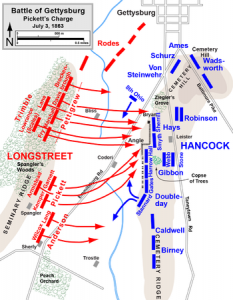 After two days of bloody stalemate, Confederate General Robert E. Lee ordered an intense bombardment of Union forces, under the command of General George G. Meade, aligned on Cemetery Ridge from Confederate artillery positions on Seminary Ridge. This bombardment was intended to soften up Union positions sufficiently to ensure a successful infantry charge across the “no man’s land” plain between the ridges by Confederate troops led by General George Pickett and two other generals.
After two days of bloody stalemate, Confederate General Robert E. Lee ordered an intense bombardment of Union forces, under the command of General George G. Meade, aligned on Cemetery Ridge from Confederate artillery positions on Seminary Ridge. This bombardment was intended to soften up Union positions sufficiently to ensure a successful infantry charge across the “no man’s land” plain between the ridges by Confederate troops led by General George Pickett and two other generals.
Bad idea. The bombardment was ineffective and the charging Confederate soldiers were sitting ducks, mowed down long before reaching Cemetery Ridge as they charged unprotected across the field.  The Confederate troops suffered casualties of more than 50%, marking the end of the Battle of Gettysburg, the northernmost thrust of the Confederate Army into Union territory, and arguably the beginning of the end for the Confederacy. When asked years later why his charge had failed, General Pickett replied “I’ve always thought the Yankees had something to do with it.”
The Confederate troops suffered casualties of more than 50%, marking the end of the Battle of Gettysburg, the northernmost thrust of the Confederate Army into Union territory, and arguably the beginning of the end for the Confederacy. When asked years later why his charge had failed, General Pickett replied “I’ve always thought the Yankees had something to do with it.”
Warfare is a favored metaphor when discussing the interactions between faculty and administration on a college campus. Both sides consider everything to be a “zero sum” game—whatever is gained on one side is automatically assumed to have been taken from the other. Each assumes the worst both in motive and will on the other side. Yet the two sides are required, at least on occasion, to interact with each other. When the need arises, the tactics and procedures are reminiscent of the Battle of Gettysburg. One side tries to soften up the other side with distractions, deflections, apparent “peace offerings,” or simply preliminary committee work—all in the hope of setting the stage for a successful frontal attack when the time is right.

Case in point: a seemingly innocuous foray by the administration into perceived faculty territory that I was in the middle of over the past few weeks.
I direct a large interdisciplinary program required of all freshmen and sophomores on my campus, a program so central to what we do that the classroom portion of the beautiful, brand new humanities building we moved into just over a year ago was designed, then built with the classroom specifications and needs of this program as the driving force.  The program is in its fourth decade of existence, but in only the second year of a re-energized and reconceived version that was the first ever serious revision of the program’s aims and pedagogy. I was approached early in the summer by some important administrators with a proposal for a “Wall of Honor” to be placed in a large, prominent location on the main floor of the building. The purpose of the Wall of Honor would be to celebrate in portrait and plaque the contributions of retired faculty (some deceased) whose contributions to the program over the years were especially noteworthy. The proposal contained a detailed description of nomination and selection processes; I was asked to first gather input from my advisory group, a small hand-picked committee of persons from the academic departments that largely staff the program,
The program is in its fourth decade of existence, but in only the second year of a re-energized and reconceived version that was the first ever serious revision of the program’s aims and pedagogy. I was approached early in the summer by some important administrators with a proposal for a “Wall of Honor” to be placed in a large, prominent location on the main floor of the building. The purpose of the Wall of Honor would be to celebrate in portrait and plaque the contributions of retired faculty (some deceased) whose contributions to the program over the years were especially noteworthy. The proposal contained a detailed description of nomination and selection processes; I was asked to first gather input from my advisory group, a small hand-picked committee of persons from the academic departments that largely staff the program, 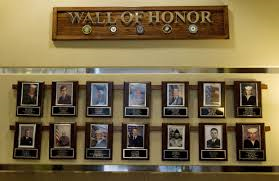 then to run the proposal past the faculty in attendance at the first full faculty meeting of the fall semester.
then to run the proposal past the faculty in attendance at the first full faculty meeting of the fall semester.
The proposal seemed both benign and well-intentioned—who could possibly be opposed to honoring both excellence in teaching and former colleagues? Doesn’t the faculty often complain that the administration does not sufficiently recognize faculty achievement? The six members of my advisory group agreed that in general it was a good idea and helpfully identified some easily fixable problems in the proposal, adjustments made by the proposers as soon as I identified them in an email following the advisory group meeting. As is my custom, I sent the program faculty at large the amended proposal by email attachment a week before the first scheduled full faculty meeting of the semester,asking them to be prepared to talk quickly about the proposal before we moved on to the more important business of the day. What could go wrong?
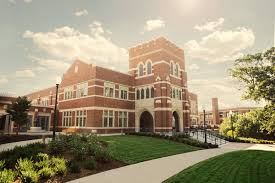
You would think that after several years of being first a department chair, then a program director that I would realize how stupid the question What could go wrong? is when anticipating a faculty meeting. In military terms, the preliminary bombardment of the faculty through contact with me, then indirectly through the advisory group, meant nothing to those present and lined up on Faculty Ridge at the department meeting. As if organized by an invisible hand, several faculty members spoke clearly and directly in quick succession about how much they hated the proposal; furthermore, they backed up their opposition with good arguments.
- The idea of singling out individuals for recognition is contrary to the spirit of interdisciplinary and collaborative teaching that we are seeking to establish and strengthen in this program.
 The first dozen or so retired faculty, perhaps more, to be honored on the wall will be old white guys, hardly a helpful image on an already too-white campus seeking to diversify both its student body and faculty. In such a highly visible place, we need to show that we are moving forward, away from an older, more patriarchal version of ourselves and towards a more inclusive, and a more welcoming, college.
The first dozen or so retired faculty, perhaps more, to be honored on the wall will be old white guys, hardly a helpful image on an already too-white campus seeking to diversify both its student body and faculty. In such a highly visible place, we need to show that we are moving forward, away from an older, more patriarchal version of ourselves and towards a more inclusive, and a more welcoming, college.- The excellence that will be honored is primarily teaching excellence, while many good but less-than-excellent faculty whose contributions behind the scenes have been immense will never be nominated or honored.
- This proposal does not facilitate the new program’s goal of reaching out to faculty across campus and incorporating them into what has, until now, been largely the domain of four large departments in the humanities.
And so on. Some of the arguments were so clearly presented that they convinced me and a couple of members of the advisory group who had entered the meeting as supporters of the proposal.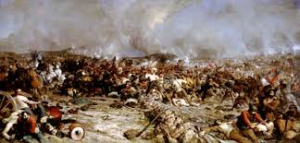 If the analogy of Pickett’s charge is appropriate, the Wall of Honor proposal never made it out of no-man’s land before it was ripped to shreds by the artillery on Faculty Ridge.
If the analogy of Pickett’s charge is appropriate, the Wall of Honor proposal never made it out of no-man’s land before it was ripped to shreds by the artillery on Faculty Ridge.
With faculty and administrators continually suspicious of and at war with each other, it’s amazing anything ever gets done on campus. The administration proposes that we all agree that the Pope is Catholic (even the current one); the faculty wonders what the real motive behind this proposal is.  The faculty senate resolves that the sky is blue; the administration wonders what they really want. In a world in which the faculty and administration by definition have radically different agendas but also arguably share many important goals, concerns and dreams in common, can we do better?
The faculty senate resolves that the sky is blue; the administration wonders what they really want. In a world in which the faculty and administration by definition have radically different agendas but also arguably share many important goals, concerns and dreams in common, can we do better?
In the aftermath of his proposal’s evisceration by the faculty, one of the administrator proposers and I had an interesting conversation in my office a week after the faculty meeting. We have gotten to know each other well over my three years of being program director—from our shared work on an important committee I have learned that he (as well as the other administrators on the committee) are remarkably human, while I believe that he (and they) have learned something similar about me. In the same room we can get many things done, even though they still roll their eyes at the faculty’s resistance to what appears to the administration to be “no brainer” common sense, while I continue to explain that the world viewed through faculty eyes is a very different world than the one perceived in the offices of Harkins Hall.
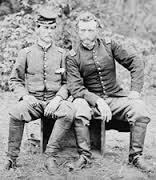 My administration colleague and I agreed that a different strategy is called for, starting with a beginning faculty discussion and vote on whether any sort of process to honor faculty is desired. If not, then we’ll move on to other more important things. If so, then I’ll try what I did last year—putting some faculty and administrators in the same room to create a joint proposal. A handful of folks from Faculty Ridge will meet halfway across no-man’s land with a handful of folks from Administration Ridge, and we’ll see what happens. Collaboration instead of suspicion? Conversation instead of bombardment? Cooperation instead of cold (or hot) war? Impossible. Ludicrous. Or is it?
My administration colleague and I agreed that a different strategy is called for, starting with a beginning faculty discussion and vote on whether any sort of process to honor faculty is desired. If not, then we’ll move on to other more important things. If so, then I’ll try what I did last year—putting some faculty and administrators in the same room to create a joint proposal. A handful of folks from Faculty Ridge will meet halfway across no-man’s land with a handful of folks from Administration Ridge, and we’ll see what happens. Collaboration instead of suspicion? Conversation instead of bombardment? Cooperation instead of cold (or hot) war? Impossible. Ludicrous. Or is it?












